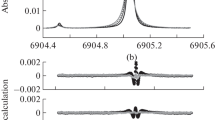Abstract
THE question whether or not the N2O molecule is linear, and if so, whether the oxygen atom occupies a position between the two nitrogen atoms or at one end, was discussed by Snow 1 some time ago. The incomplete evidence then available seemed to favour the symmetrical configuration. We have, however, been able to show conclusively that the molecule is unsymmetrical, though linear.2 The form of the bands and the spacing of the rotation lines is inconsistent with any but the linear model. The selection rules for vibrational transitions and for the appearance of zero branches, and the fact that all three fundamental frequencies are optically active, indicate the asymmetry.
Similar content being viewed by others
References
Proc. Roy. Soc., A, 128, 294; 1930.
Physical Renew, 38, 1827; 1931.
Rev. Mod. Phys., 3, 280; 1931.
Z. Physik, 70, 84; 1931.
NATURE, 127, 817; 1931.
Author information
Authors and Affiliations
Rights and permissions
About this article
Cite this article
BARKER, E. Raman Lines and Infra-Red Bands in Nitrous Oxide. Nature 129, 132–133 (1932). https://doi.org/10.1038/129132b0
Issue Date:
DOI: https://doi.org/10.1038/129132b0
- Springer Nature Limited




